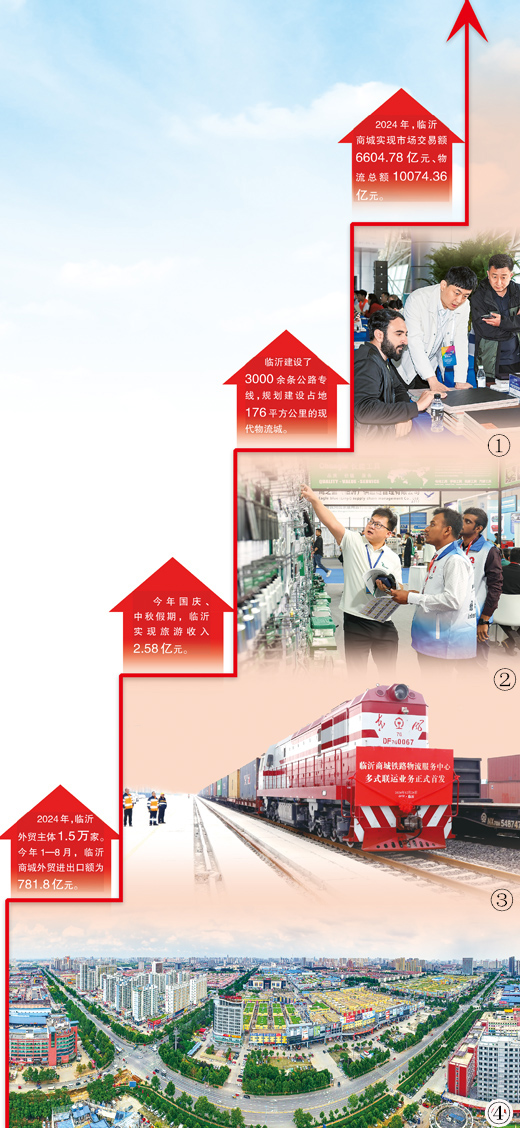




- BRNN
- BRI News
- BRNN News
- Database
Official Documents Polices and Regulations
Inter-government Documents International Cooperation BRI Countries
Business Guide Economic Data BRI Data
Trade
Investment Projects Latest projects
Cases - Content Pool

①: A foreign buyer explores business opportunities at the 2025 Linyi Whole-House Customization and Supply Chain Exhibition held in Linyi, east China's Shandong Province. (Photo/Zhang Jinxin)
②: An exhibitor speaks with foreign buyers at the third Linyi Trade City International Sourcing Conference for Belt and Road Cooperation in Linyi, east China's Shandong Province. (Photo/Yin Zhaogong)
③: Photo shows the first train of the multimodal transport service of Linyi Trade City's railway logistics service center in Linyi, east China's Shandong Province, in December 2024. (Photo/He Kegong)
④: Photo shows a panoramic view of Linyi Trade City in Linyi, east China's Shandong Province. (Photo/Zhang Fengchuan)
In early spring 1981, Chen Wenbiao left Yiwu in east China's Zhejiang Province for Linyi in east China's Shandong Province, carrying 20,000 buttons to sell. Today, Chen has become a leading entrepreneur in Linyi Trade City.
Over 44 years, he has witnessed Linyi Trade City transform from roadside stalls into an international shopping hub. His entrepreneurial journey mirrors the city's own evolution from a revolutionary base area into an important national trade and logistics center.
In 2024, Linyi Trade City recorded 660.48 billion yuan ($92.89 billion) in market transactions and more than 1 trillion yuan in logistics volume.
When Chen first arrived in Linyi, he stumbled upon a local market day. Near a long-distance bus station, he laid out a plastic sheet beneath a stand of poplar trees, arranging his buttons by color for sale.
The following spring, Linyi Trade City's first iteration took shape in Lanshan district. Cement platforms served as fixed stalls, hosting more than 600 merchants selling thousands of product varieties.
Over the next 10 years or more, specialized wholesale markets for clothing, footwear, stationery and other goods sprang up in Linyi. Chen's inventory expanded from buttons to adhesive tape and student supplies. In 1991, he moved his stall to the newly built Lantian Cultural and Sports Market, where business flourished.
Today, Linyi, known nationwide as the "logistics city of China," boasts the country's largest cluster of specialized markets, serving as a vital logistics hub and wholesale center.
In 2014, riding the wave of Linyi Trade City's growth, Chen founded a cultural product company. Two years later, he received a national honorary title for entrepreneurship.
Sensing a trend toward consumption upgrading, Chen pivoted into the creative cultural industry two years later. His company now distributes products from dozens of well-known cultural brands across regions north of the Yangtze River. Many of its products quickly become market hits.
Chen's success reflects Linyi's broader commercial vitality. Currently, Linyi is home to 136 specialized wholesale markets, 63,700 shops and 46,000 business households, employing 1 million people in trade and logistics. Its products span 27 major categories and over 6 million varieties, covering nearly all major production and consumer goods.
Linyi has been vigorously advancing its "commerce and logistics first" development strategy, establishing more than 3,000 dedicated highway logistics routes and building a 176-square-kilometer modern logistics hub. The hub's first phase houses 1,738 relevant enterprises. Goods traveling within 600 kilometers arrive the next morning, those within 1,500 kilometers the following day, and those within 3,000 kilometers by the third day. Logistics costs run roughly 30 percent below the national average.
"Linyi has formed an industrial pattern where markets drive logistics and logistics serve commerce," said Wu Chuanliang, head of the Linyi Trade City Management Committee.
At present, Linyi Trade City operates 22 logistics parks and hosts more than 2,200 logistics enterprises, providing employment for 580,000 people. Its logistics networks cover 2,100 outlets above the county level nationwide and reach all ports and points of entry in China.
Since last year, the Linyi Trade City Management Committee has upgraded infrastructure, environment and services to meet A-level tourist attraction standards, creating 15 immersive, scenario-based shopping zones that blend commerce with local customs.
The Linyi Small Commodities City tourism area has been approved as a national 3A-level tourist attraction, Wu said.
During this year's National Day and Mid-Autumn Festival holidays, 21 key tourist attractions in Linyi received 3.87 million tourist visits, generating 258 million yuan in tourism revenue, up 14.53 percent and 19.34 percent year on year, respectively. Linyi Trade City alone attracted more than 900,000 shoppers, with total transactions exceeding 40 million yuan.
In recent years, Linyi Trade City has also accelerated its "going global" strategy. Linyi city has established 59 overseas commercial centers and warehouses and obtained 13 certifications from the Global Association of the Exhibition Industry (UFI). It organized over 1,500 enterprises to explore overseas markets in 2024.
From January to September this year, Linyi Trade City welcomed 32,700 visits from international buyers. The third Linyi Trade City International Sourcing Conference for Belt and Road Cooperation, held Oct. 10-13, attracted more than 2,000 international buyers from 99 countries and regions. Last year, Linyi Trade City attracted 31,000 overseas buyers.
Since 2022, Linyi has been guiding enterprises within Linyi Trade City to expand foreign trade, organizing numerous training sessions. More than 4,000 local foreign trade operators have joined cross-border e-commerce platforms such as Amazon and Alibaba.
In 2024, the number of foreign trade entities in Linyi rose to 15,000, ranking fifth in Shandong Province, with cross-border e-commerce transactions reaching 25.2 billion yuan, contributing 4.2 percentage points to the city's import-export growth.
From January to August this year, Linyi Trade City's market transaction volume totaled 471.79 billion yuan, up 8.4 percent year on year. Logistics volume reached 719.26 billion yuan, up 12.4 percent, while foreign trade volume hit 78.18 billion yuan, up 4.2 percent.

Tel:86-10-65363107, 86-10-65368220, 86-10-65363106